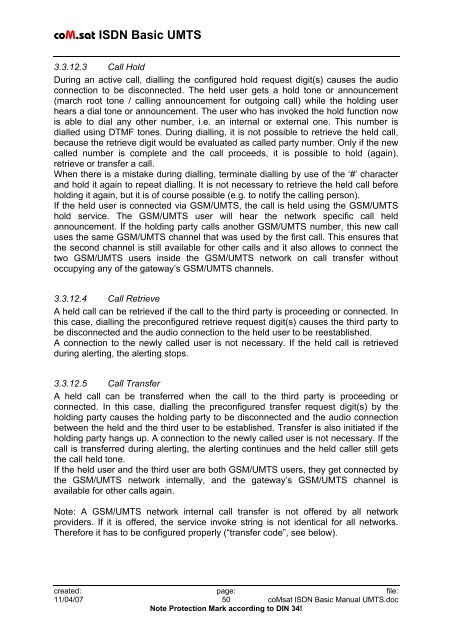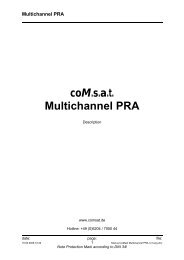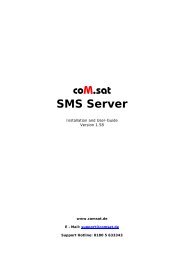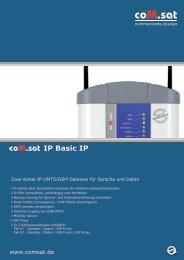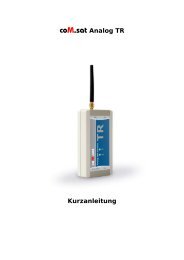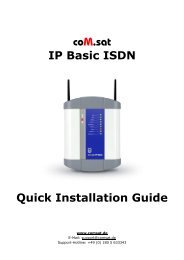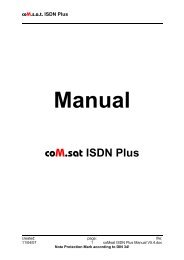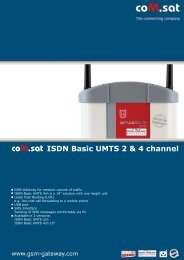coM.sat ISDN Basic UMTS
coM.sat ISDN Basic UMTS
coM.sat ISDN Basic UMTS
You also want an ePaper? Increase the reach of your titles
YUMPU automatically turns print PDFs into web optimized ePapers that Google loves.
<strong>coM</strong>.<strong>sat</strong> <strong>ISDN</strong> <strong>Basic</strong> <strong>UMTS</strong><br />
3.3.12.3 Call Hold<br />
During an active call, dialling the configured hold request digit(s) causes the audio<br />
connection to be disconnected. The held user gets a hold tone or announcement<br />
(march root tone / calling announcement for outgoing call) while the holding user<br />
hears a dial tone or announcement. The user who has invoked the hold function now<br />
is able to dial any other number, i.e. an internal or external one. This number is<br />
dialled using DTMF tones. During dialling, it is not possible to retrieve the held call,<br />
because the retrieve digit would be evaluated as called party number. Only if the new<br />
called number is complete and the call proceeds, it is possible to hold (again),<br />
retrieve or transfer a call.<br />
When there is a mistake during dialling, terminate dialling by use of the ‘#’ character<br />
and hold it again to repeat dialling. It is not necessary to retrieve the held call before<br />
holding it again, but it is of course possible (e.g. to notify the calling person).<br />
If the held user is connected via GSM/<strong>UMTS</strong>, the call is held using the GSM/<strong>UMTS</strong><br />
hold service. The GSM/<strong>UMTS</strong> user will hear the network specific call held<br />
announcement. If the holding party calls another GSM/<strong>UMTS</strong> number, this new call<br />
uses the same GSM/<strong>UMTS</strong> channel that was used by the first call. This ensures that<br />
the second channel is still available for other calls and it also allows to connect the<br />
two GSM/<strong>UMTS</strong> users inside the GSM/<strong>UMTS</strong> network on call transfer without<br />
occupying any of the gateway’s GSM/<strong>UMTS</strong> channels.<br />
3.3.12.4 Call Retrieve<br />
A held call can be retrieved if the call to the third party is proceeding or connected. In<br />
this case, dialling the preconfigured retrieve request digit(s) causes the third party to<br />
be disconnected and the audio connection to the held user to be reestablished.<br />
A connection to the newly called user is not necessary. If the held call is retrieved<br />
during alerting, the alerting stops.<br />
3.3.12.5 Call Transfer<br />
A held call can be transferred when the call to the third party is proceeding or<br />
connected. In this case, dialling the preconfigured transfer request digit(s) by the<br />
holding party causes the holding party to be disconnected and the audio connection<br />
between the held and the third user to be established. Transfer is also initiated if the<br />
holding party hangs up. A connection to the newly called user is not necessary. If the<br />
call is transferred during alerting, the alerting continues and the held caller still gets<br />
the call held tone.<br />
If the held user and the third user are both GSM/<strong>UMTS</strong> users, they get connected by<br />
the GSM/<strong>UMTS</strong> network internally, and the gateway’s GSM/<strong>UMTS</strong> channel is<br />
available for other calls again.<br />
Note: A GSM/<strong>UMTS</strong> network internal call transfer is not offered by all network<br />
providers. If it is offered, the service invoke string is not identical for all networks.<br />
Therefore it has to be configured properly (“transfer code”, see below).<br />
created: page: file:<br />
11/04/07 50 <strong>coM</strong><strong>sat</strong> <strong>ISDN</strong> <strong>Basic</strong> Manual <strong>UMTS</strong>.doc<br />
Note Protection Mark according to DIN 34!


